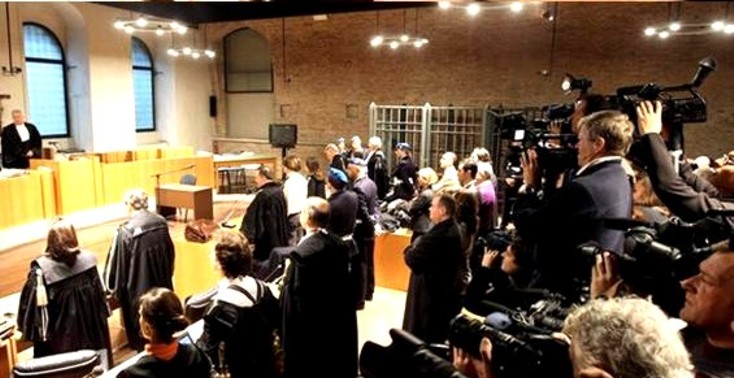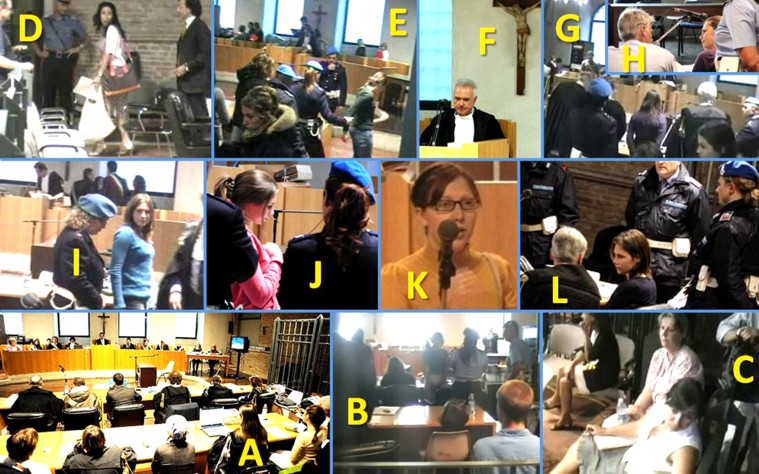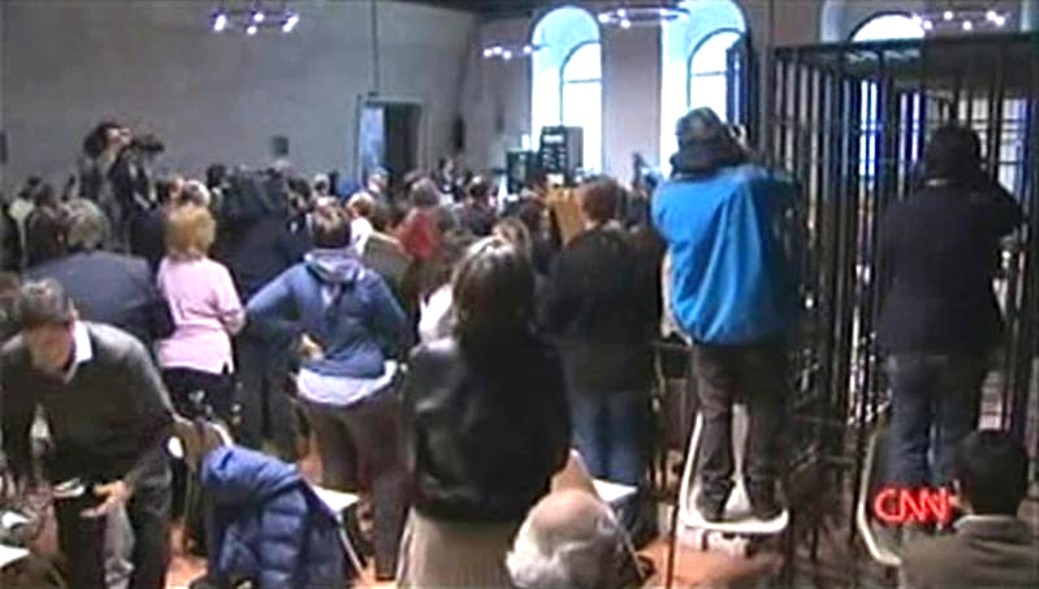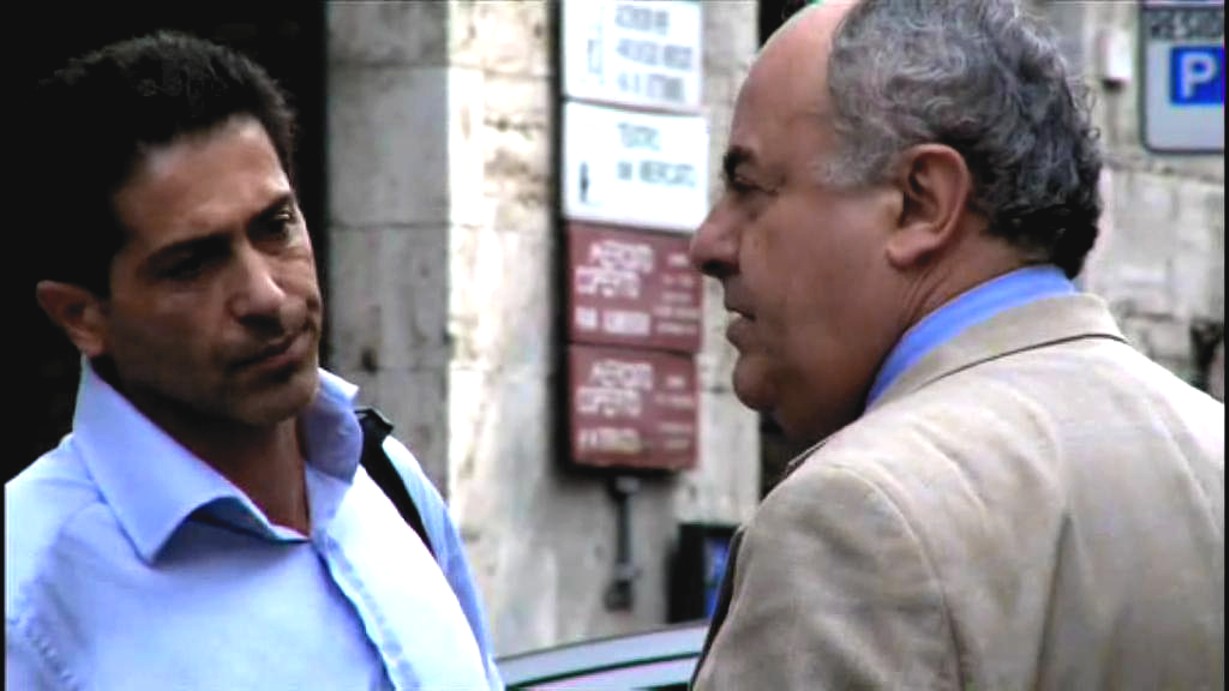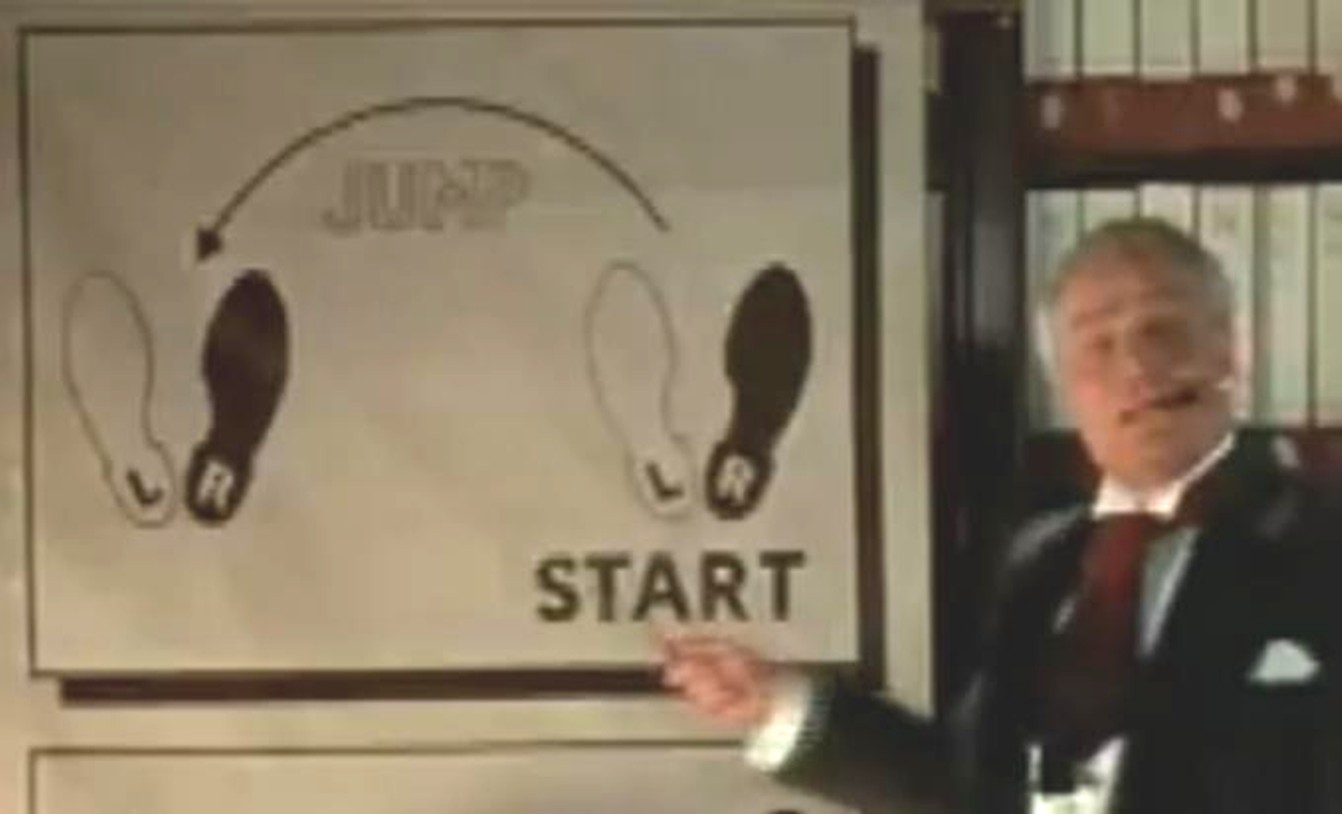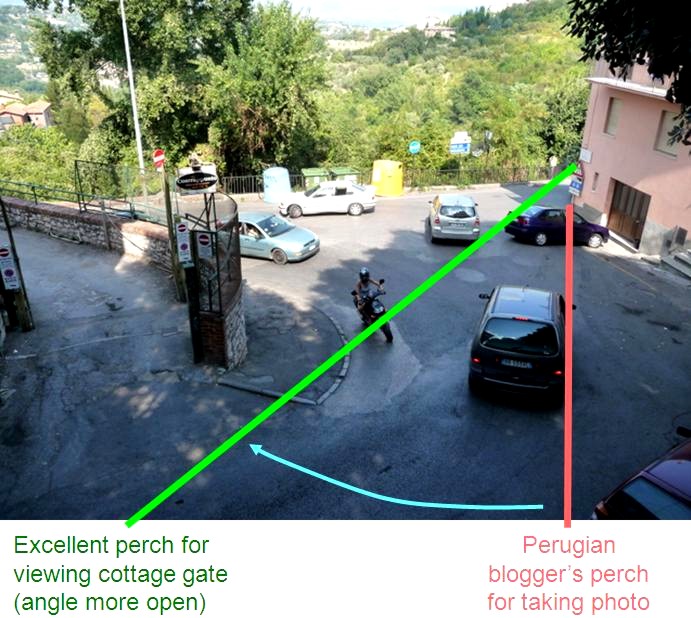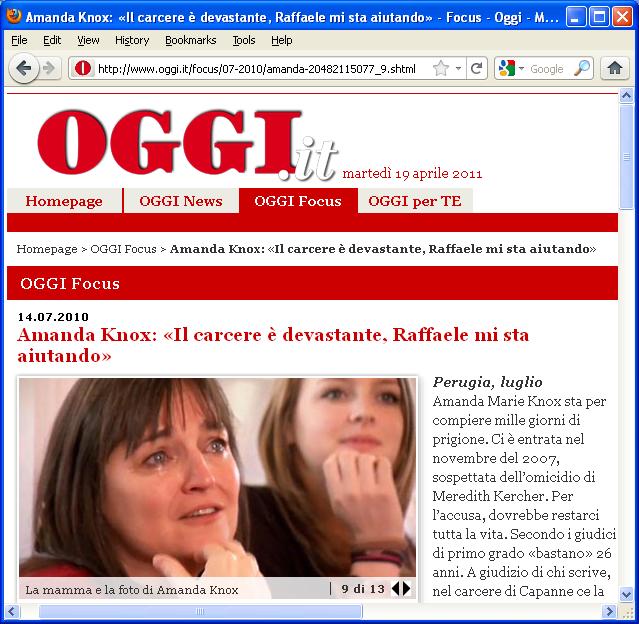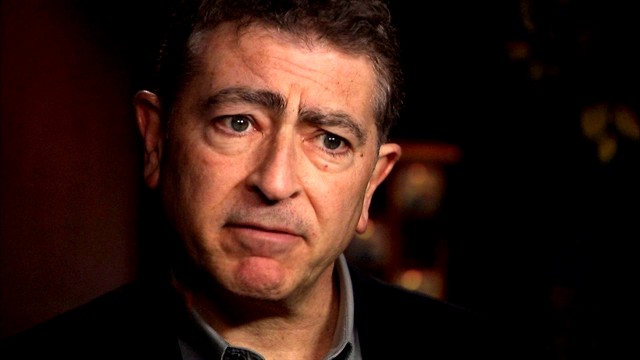
Category: 9 Mignini v Knox hoax
CPJ Accusation #2 Against Italian Justice Officials : Did Court Officials Hassle The Anon Blogger?
Posted by Kermit
Overview. In our Second Open Letter to Joel Simon and world leaders we noted that NOT ONE of the accusations against Italian officials on close examination stands up. This is Attachment Two to that letter. More investigative posts are to come.
CPJ Accusation #2: The CPJ letter makes a second accusation against Mr. Mignini concerning supposed (yet unsubstantiated) abuse that Mr. Mignini has organized against this blogger: “When the trial of Knox and Sollecito began that December, Squadra Mobile continued to harass him. They regularly tried to prevent him from entering the court; seized his cellphone and went through his contacts and text messages; mouthed insults at him from across the courtroom; and stared over his shoulder as he took notes. “This was done in the presence of the judge, the Carabinieri [the military police], and the court guards, but they would do nothing,” Sfarzo (real name Sforza) told CPJ.” (Source: CPJ’s Letter to the World 19-04-2011)
Line of Investigation for Test 2: For many of these cases of supposed abuse and threats, the best source for contrasting the grave accusations which the CPJ heaps rather flippantly on Mr. Mr. Mignini, are the words and images that the supposed victims themselves post on Internet.
The Perugian blogger didn’t take photos or video of the entrance controls to the courthouse. I can imagine that in this day and age of terrorism and security controls, it would have been normal for the guards to have asked the blogger’s purpose in entering the courthouse, and if he said he was a member of the press (promoted to “local freelance reporter” by the CPJ), it would have been normal for them to expect him to produce a press pass, accreditation, media business card, or any other professional identification.
And if he didn’t have press identification and if he wasn’t a member of the families of the defendants, or there as a guest of the Kerchers or the prosecution, I can imagine that he would have had some difficulty initially getting access to the courtroom.
Anyway, let’s assume that the credibility of the first part of this accusation (being hassled when entering the courthouse) has the same level of credibility of the second half of this accusation (being insulted and spied on within the courtroom).
If you agree, let’s first of all take a fast look at the general news agency photos of the courtroom which you saw in my first letter a couple of weeks ago. The test will be to contrast those photos with the blogger’s own photos from court sessions, in order to understand the possibility that such harassment occurred.
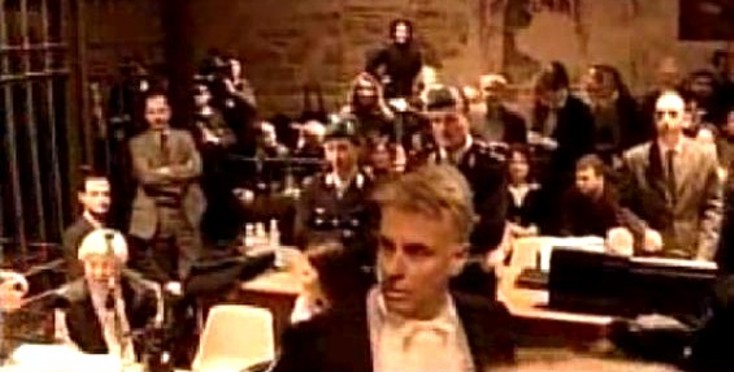
[At top and above: The Perugian courtroom where Amanda Knox and Raffaele Sollecito were tried, and where the CPJ claims that the Perugian blogger was yet a further victim of this trial.]
To the right of the upper photo, and at the back of the lower photo is the press pen, where members of the press are crammed in and must remain between a railing and a back wall.
In front of the press pen railing are the defendants’ family members and other authorized parties.
In front of family members, guards separate the defendants and their legal teams from their families. (To the left of the legal defence teams are the prosecution and private plaintiffs.)
Opposite the prosecution and defence legal teams, facing them at the front, are the judge and the members of the judicial jury.
Test 2, Step 1: Google: site:blogspot.com perugia shock court (enter)
(Please note that even though the Perugian blogger’s site has been removed, you can still get photos and text through Google caches.)
Approximate time required to obtain material to be analysed: less than 1 second
Analysis:
The pro-Amanda Knox lobbyist blogger’s blogspot lobby pages (or, if you prefer, the “local freelance reporter’s” news publishing page) are chock full of photos in the court sessions of the trial of Amanda Knox and Raffaele Sollecito.
Let’s make a collage of them:
[Above: A jammed pack collage of photos from the Perugian blogger’s blogspot “freelance reporting” page: http://perugia-shock.blogspot.com/ (I never knew that by having a blogspot page you became a freelance reporter. Neat.) Double click on the above image to see a larger resolution version. ]
I have indicated each individual photo with a letter. From my point of view, the Perugian blogger was where he should have been in all instances, which is behind the railing of the press pen, near the back wall of the courtroom. This is clearly the case in photos “B”, “C” and “D”, where you can actually see the railing which separates the press pen from the rest of the courtroom.
In the rest of the photos, especially when the zoom function is obviously in use, such as in photos “H”, “J” or ” K”, or simply by gauging perspective, such as in the case of photo “L”, it’s safe to say that the Perugian blogger in all cases was behind the railing of the press pen.
Let’s place on a sketch of the courtroom, the location from which the Perugian blogger took those photos in Amanda Knox court sessions he attended:
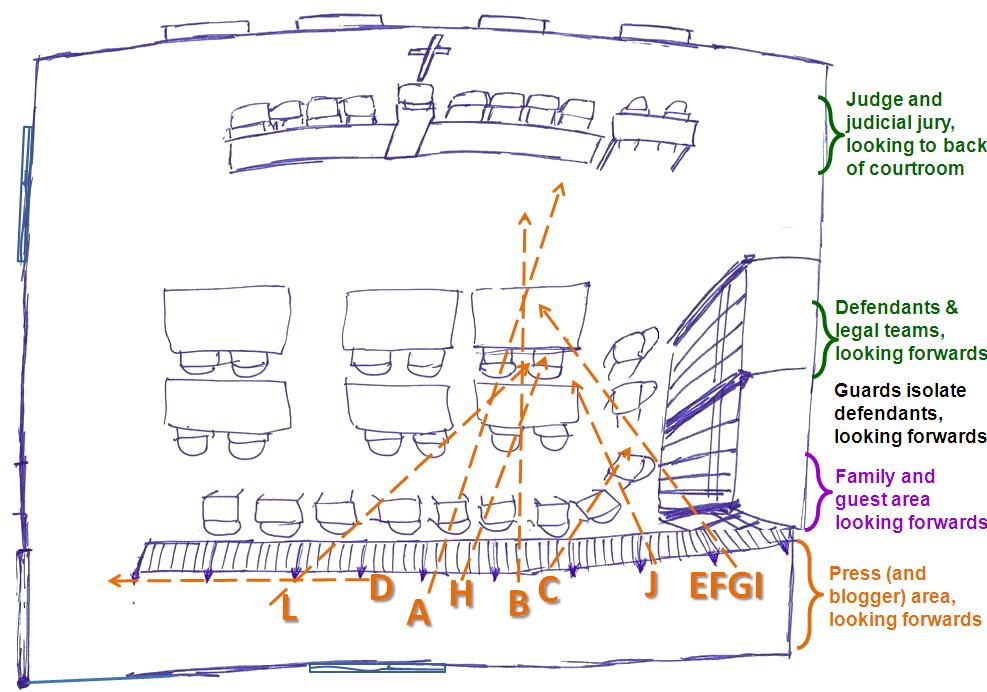
Now, if the blogger was in the press pen, any police officer who would have stepped into the crowded, fenced off area and wandered around behind the backs of the journalists, reporters, and blogger - especially making a noticeable attempt to look over shoulders - would have been noticed by the journalists in addition to the blogger who has accused Mignini of sending these spies out.
I realize that these photos may not represent all of the court sessions that the blogger attended. The possibility exists that in some other session he wasn’t in the press pen, but sitting with the Knox-Mellas family, with whom he has a personal relationship, or in some other non-press location in the courtroom.
Since the CPJ calls the Perugian blogger a freelance reporter, I would assume that the CPJ would also situate the blogger in the press pen and assume that if he wasn’t attending as a member of the press but as a friend of some defendant, then he shouldn’t be afforded the protection of the CPJ (in any case, I doubt this scenario occurred).
As for the “mouthing of insults”, in general, everybody faces forward in the courtroom, except for the judge and the members of the judicial jury. Any police officer or carabinieri agent or prison/court guard present would have been mouthing to the whole press corps plus the blogger, not just him.
[Above: As we see from this photo, everyone in the courtroom faces forwards, except the judge and the jury “¦ and the Perugian blogger (I think that’s him there on the left looking backwards). Golly, maybe he was spied on over his shoulder after all.]
It requires a Friends of Amanda Leap of Faith to imagine the alleged spying happening without anyone else detecting it, other than the blogger.
I won’t comment on the possibility that Judges Micheli, Massei or Hellman condone or are accomplices to such behavior. I honestly think that the CPJ should think twice before it spreads so much conspiracy around, on the basis of a verbal statement by a blogger whose real name the CPJ didn’t even know when they spoke to him (you did speak to him, right? Or did someone else do the phone interview on your behalf?).
If the CPJ honestly thinks that this behavior occurred, since the presiding judge has responsibility for what goes on in the courtroom, why didn’t the CPJ Letter to the World accusing Mignini not make nominal reference to the judges who pull rank over Mignini and include them in this specific accusation?
Test 2, Step 2: Conclusion
Having seen in a more detailed way the layout of the courtroom and the normal positioning of the Perugian blogger, it is difficult to imagine how he may have been spied upon by policemen looking over his shoulder.
As for the mouthing of insults, as a rule, the guards face forwards and are located in front of the family members and other invited persons. For a guard to turn towards the Perugian blogger and mouth an insult, not only the other journalists would have seen it, but also the guests and probably lawyers as well.
If any insults were mouthed at the Perugian blogger during the course of the Amanda Knox trial, or the start of the subsequent appeal, it is difficult to believe that this could have occurred with only the presiding judge (in addition, of course, to the ringleader Mignini) realizing what was going on.
It’s time to go back to the Balance Sheet for Testing CPJ’s Anti-Mignini Accusations and update it:
[Below: Click image for larger image.. The second test of credibility in the anti-Mignini accusations could only be passed if the person who formulated it took a giant Friends of Amanda Leap of Faith.]
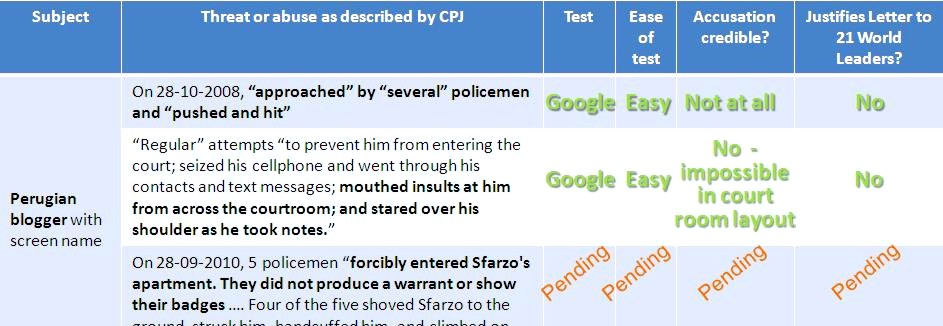
CPJ Accusation #3 Against Italian Justice Officials : Was Anon Blogger Arrested On MIGNINI’S Orders?
Posted by Kermit
Overview. In our Second Open Letter to Joel Simon and world leaders we noted that NOT ONE of the accusations against Italian officials on close examination stands up. This is Attachment Three to that letter. More investigative posts are to come.
Accusation 3: This anti-Mignini accusation is even more startling than numbers one and two. The harassment reached its peak on September 28, 2010, when five officers of Squadra Mobile forcibly entered “Sfarzo’s” apartment. They did not produce a warrant or show their badges, “Sfarzo” (real name Sforza) told CPJ. Four of the five shoved Sforza to the ground, struck him, handcuffed him, and climbed on top of him, crushing his air supply “¦ etc. etc. etc. The officers refused Sforza’s requests to call his lawyer or his relatives, and put him in a cell for the night.” (Source: CPJ Letter to 21 World Leaders )
Well, I’m still surprised that CPJ didn’t ask the Perugian blogger for his lawyer’s name, or for information about the hospital and the doctors who attended him.
I’m also surprised that CPJ didn’t ask both the blogger and the police headquarters about why the accused policemen (with or without a warrant) originally went to his home. It all sounds like a story that is extremely full of holes of information which should be filled (unless if you prefer not to fill them in).
I don’t know if the CPJ realized it, but with this accusation, the organisation has ratcheted up the grave accusations against Mignini. If up until now the anti-Mignini crowd’s accusations were limited to describing Mignini’s alleged bothersome provocations, the CPJ has now appeared on the anti-Mignini stage, and is claiming that he has opened a qualitatively higher level of menace: one of physical violence causing bodily harm. The only thing missing is for Mignini to be called a drug-dealer and a drifter.
Since the CPJ didn’t ask the blogger nor include in its Letter to the World why the police went to the blogger’s home, the CPJ’s insinuation is that Mignini’s goon squad simply went to the blogger’s home under that prosecutor’s orders, and with no justification.
I see no evidence that:
- Mignini sent anyone anywhere that day,
- the police weren’t there (if they were) on police business related to the Perugian blogger’s real-life persona,
- the altercation with the blogger (if there was one) had something to do with Mignini,
- the injuries suffered by the blogger were noticeable (if there were any),
- the blogger’s neighbour was contacted the CPJ, as a first hand eye-witness.
The CPJ letter quotes the Perugian blogger: “The next day, the officers brought Sfarzo (real name Sforza) before a local judge, who validated his arrest and indicted him on several articles of Italy’s penal code “¦. ‘The police can count on the complicity of judges,’ Sfarzo told CPJ”.
If Joel Simon of the CPJ ratcheted up the level of the attack on Mignini by claiming that physical bodily-damaging violence is now part of MIgnini’s media relations program, our astonishment is increased with the new and confusing element of the judges’ complicity. If Mignini is the ringleader, shouldn’t he be the one who has the complicity of the judges, instead of the national policemen, who up until now seem to be footsoldiers of Mignini?
You tell a tale in the Letter to 21 World leaders which is confusing. Please provide us with a believable link between Mignini, police officers and judges in this violence. Who’s the leader?
Well, we’re here to do a check on the third Anti-Mignini Accusation of the CPJ. There is no direct evidence of this strange supposed attack available for me to go on, so I think I’ll have to do a credibility check on the Perugian blogger’s words and photos in other situations where Mignini is present, such as regards the Meredith Kercher murder investigation.
Forensics Method for Test 3: Google, and reading up on the murder of Meredith Kercher
Line of Investigation for Test 3: Since the Perugian blogger’s blog is sometimes difficult to understand for me, due to English language expression issues, or due to his particular sense of humour, we need to contrast his credibility in a direct, visual and non-verbal manner.
Test 3, Step 1:
Step 1a: Talk with someone familiar with the online discussion of this case. Ask about situations where the Perugian blogger has undermined his own credibility in a obvious, relevant and conscious way, comparing these situations to the credibility he needs to support his colourful description of a Mignini directed police commando which storms into the house of the blogger for no reason whatsoever other than to beat him up (a qualitative change from the other accusations that the blogger has made against Mignini, and which haven’t stood up to scrutiny) and make it look like the blogger attacked them, all in order to try him and send him to jail.
I’m not looking for situations of the typical silly comments which we may make at one time or another due to human foible, but where a direct, explicit decision or affirmation is made which undermines one’s overall credibility.
Today we’ll look for just one situation to analyse. However, I’m open to examine other such events or declarations, especially if the CPJ finally decides to start to do basic checking behind the details of its recent attack on Mr. Mignini. We can hopefully work together on this in the future.
Step 1b: Take the key elements of the above situations commented on where the Perugian blogger is involved, and follow the development of the discussion.
Google: perugia shock via della Pergola from where raffaele amanda checking house (enter)
Approximate time required to obtain material to be analysed: minutes/few hours
Analysis:
Let’s go back in time to the end of November and start of December of 2008. There was an open debate then on a pro-Knox cooking blog based in Seattle which has since become dedicated to the Amanda Knox case. At that point one of the many Internet forum debating issues concerning the crime committed against Meredith Kercher was whether it is possible from Piazza Grimana to see the gate of the cottage where Meredith lived together with Amanda Knox, her now convicted murderer (pending appeal), and two other Italian girls.
Piazza Grimana is a park/pedestrian square with a basketball court, carved into a downhill slope just outside of Perugia’s ancient Etruscan Arch. The prosecution maintained a theory that following the murderous act for which they have been convicted, Knox and Sollecito could have waited in the Piazza Grimana, looking towards the access ramp of the cottage to see who might arrive (perhaps, for example, emergency vehicles).
Obviously, the cooking blog curator didn’t manage to clear up this debate in her favour, but the Perugian blogger, who was already on excellent terms with pro-Knox forces “came to the rescue” on his blogspot pages with this image which seems to demonstrate that the view of the cottage access ramp from Piazza Grimana is blocked by the building on the right:
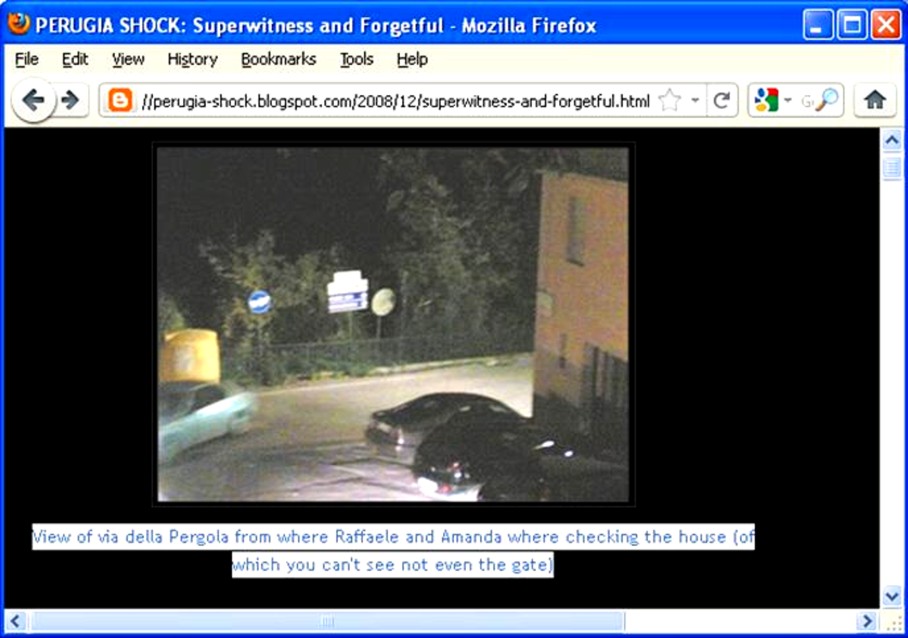
Above: The Perugian blogger provided momentary pressure release for the cooker, by posting this image with the accompanying text to emphasize that you can’t see the cottage gate from Amanda Knox’s and Raffaele Sollecito’s alleged perch on the raised edge of the Piazza Grimana. The logic of the argument is that if neither you nor I can see the cottage gate (in that photo), then neither could Knox nor Sollecito, and therefore the prosecution theory was not applicable.
The Perugian blogger’s photo from Piazza Grimana was perfect for the requirements of the cooking blogger, and a grateful post soon went up on her site:
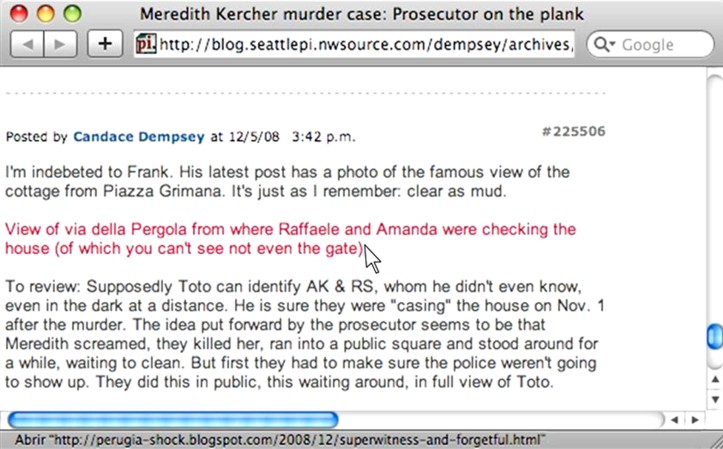
Above: A pro-Knox Seattle food blogger with a personal blog on the Seattle PI site was relieved to have visual support for her theory that the view of the cottage gate from Piazza Grimana is “clear as mud”. (Source: Seattle PI amateur blog Note: this comment and other followup ones were cleansed ““ erased ““ a long time ago. )
The online blog discussion could have drifted on to other topics if it weren’t for the fact that many of us knew perfectly well that you can see the cottage gate from Piazza Grimana. Even a person not familiar with this case, upon examining the apparent proof provided by the Perugian blogger that the building on the right might negate the possibility of two murderers staking out the cottage entrance ramp, could come up with an effective answer :
Above: It’s just a jump to left, that’s all that is required to gain the line of vision needed to watch the access to the cottage. (Source: Rocky Horror Picture Show)
Above: Let’s try something extremely obvious that the Perugian blogger seems to have avoided in evaluating whether you can see the cottage gate from Piazza Grimana “¦ what will happen if we move a little to the left?
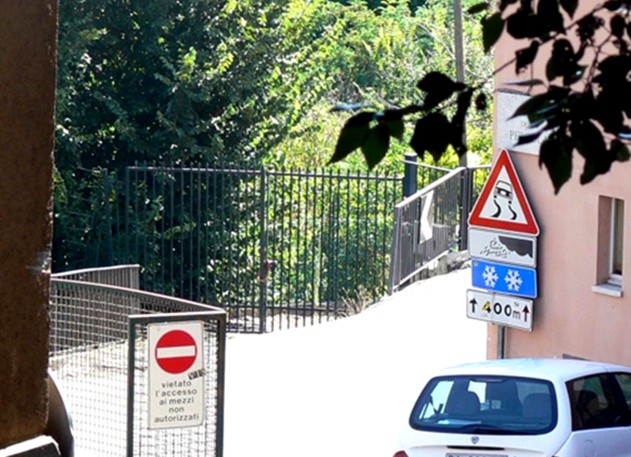
Above: Luckily, the TJMK editor had been in Perugia and came back with an extensive collection of photos of the things he had seen, including the view of the cottage access ramp from Piazza Grimana.
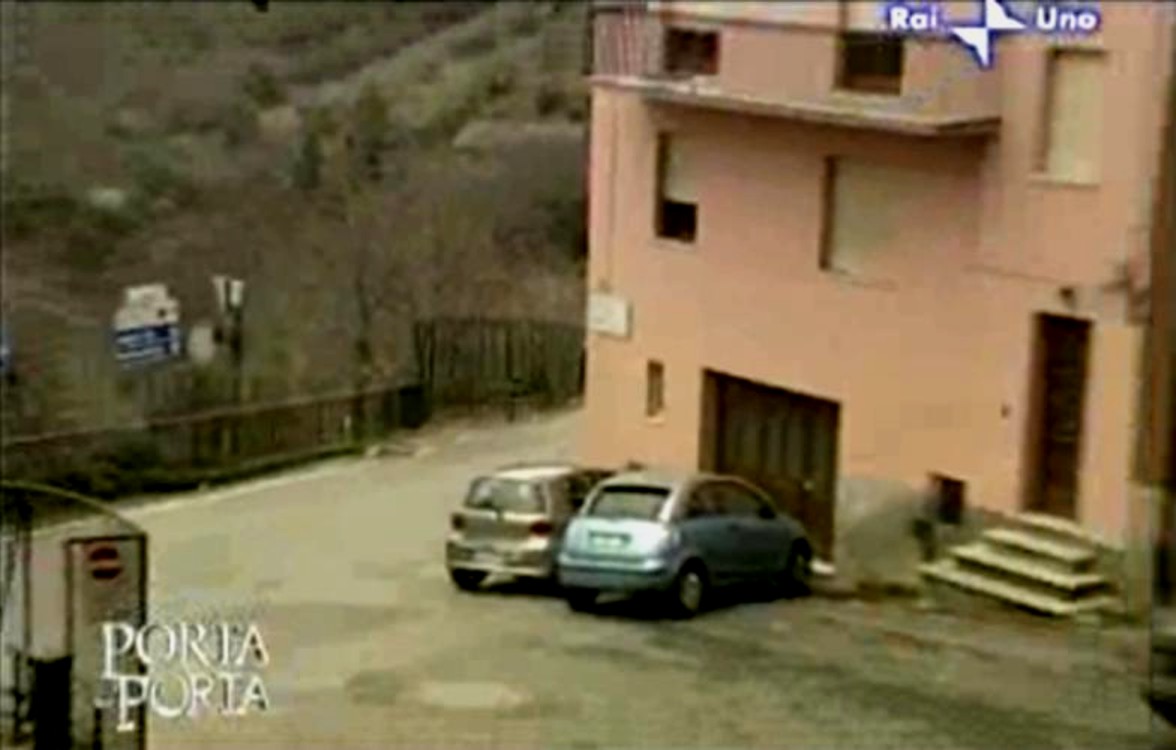
Above: Even Italian television was providing the view that Knox and Sollecito may have had from Piazza Grimana of the cottage gate. Why would the Perugian blogger and his pro-Knox lobby group associates want to deny this view from the English-language debate on the case?
If from just a couple of metres to the left you get a completely different story compared to the shadows to the right, and that makes plausible one element of a prosecution theory, I would have thought that a real freelance reporter would not avoid reporting on the obvious.
Test 3, Step 2: Conclusion
This test has been a credibility check. My opinion is that if the Perugian blogger applies the Jump-to-the-right book of extra-judicial lobby blogging, instead of the Jump-to-the-left book of journalistic reporting ““ to the detriment of the prosecution of a criminal case ““ then it is within the realm of reason that such a tendency toward misinformation / incomplete information about Mignini could also be applied by the blogger in describing to CPJ a Mignini-directed violent attack by rogue policemen loyal to Mignini and not their superiors, and who had no other reason to appear at the home of the real person behind the Perugian blogger’s screen-name other than to threaten him into not writing about a case that was already long out of the hands of said prosecutor.
Let’s update the Balance Sheet for Testing CPJ’s Anti-Mignini Accusations and see where things stand:
[below: The results of the third test of credibility in the anti-Mignini accusations only serve to worsen the state of the CPJ’s own credibility.]
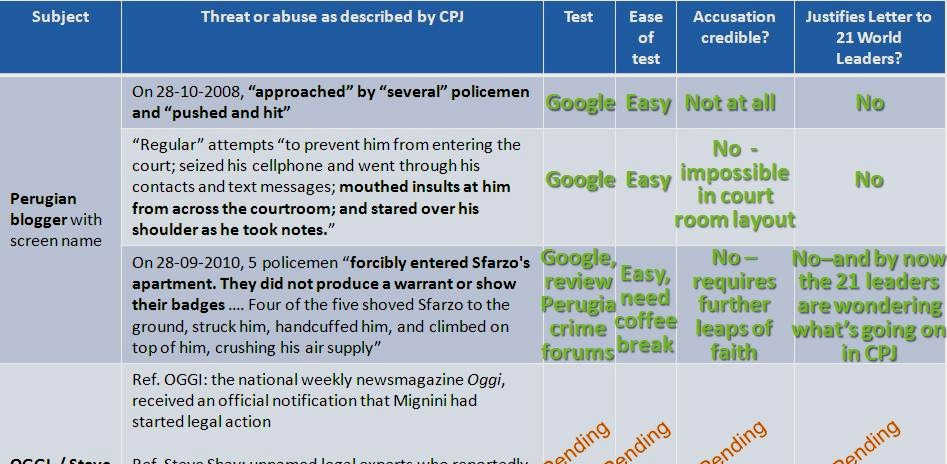
CPJ Accusation #4 Against Italian Justice Officials: Mr Mignini Sues For Defamation Without Cause?
Posted by Kermit
Overview. In our Second Open Letter to Joel Simon and world leaders we noted that NOT ONE of the accusations against Italian officials on close examination stands up. This is Attachment Four to that letter. More investigative posts are to come.
CPJ Accusation 4: “[CPJ] an independent, nonpartisan organization dedicated to defending the rights of journalists worldwide, is deeply concerned about local authorities’ harassment of journalists and media outlets “¦. CPJ is particularly troubled by the manifest intolerance to criticism displayed by Perugia Public Prosecutor Giuliano Mignini, who has filed or threatened to file criminal lawsuits against individual reporters, writers, and press outlets…. [Editor of] the national weekly newsmagazine Oggi, received an official notification that Mignini had started legal action against him in response to an Oggi article…. the U.S. weekly newspaper West Seattle Herald”¦ published an article that “¦ contained a reference to unnamed legal experts who reportedly believed Mignini to be “mentally unstable.” “¦. swift reaction by Mignini “¦ (who) file a defamation claim against the West Seattle Herald… Joe Cottonwood, another U.S. writer Mignini has threatened with a criminal defamation lawsuit ... the action stems from a “¦ comment (where) Cottonwood described Mignini as an “intellectually dishonest bully.” (Source: CPJ Letter to 21 World Leaders 19-04-2011 ) “What we are concerned about is that the press - domestic and international - is free to report and comment on the case without fear of reprisal.” (Source: CPJ followup explanatory note 28-04-2011. )
First a clarification. Joel Simon presumably means the press should be free to report accurately and without unfounded libelous smears. Let’s hope that he doesn’t really maintain reporters’ rights to defame without basis, to provoke unhinged ranters on the web who channel hate against the Perugia officials and those who support them day-in and day-out.
Forensics Method for Test 4: Common sense and a little Google
Line of Investigation for Test 4: Let’s get this straight: here the CPJ is concerned that reporters and news media will not freely report or express opinions in the case of the murder of Meredith Kercher. The CPJ believes that this is happening because of threats by Mr. Mignini.
I think that we should check to what extent the press actually feels threatened, and to what extent they are modifying their comportment due to Mr. Mignini’s supposed inappropriate actions which the CPJ considers go beyond what could be reasonably expected.
Test 4a, Step 1:
Google: judge sues newspaper defamation (enter)
You get 1,750,000 results, so it’s clear that the fact that members of the judiciary sue the press is not something that Mr. Mignini invented. You probably see where I’m going, so I’ll save us the effort of doing a few additional seconds of Googling different combinations like:
- Google: judge sues radio slander (enter)
- Google: judge sues media defamation (enter)
And so on. You end up with many, many millions of Google responses.
Since I’m trying to limit the execution of this test to a matter of seconds, let me take one of the mundane examples from the first page of Google results: this spring, the Voice of Richmond, a small local newspaper in Richmond, Virginia, was sued for the second time in two years, by the judge and a lawyer in the first case.
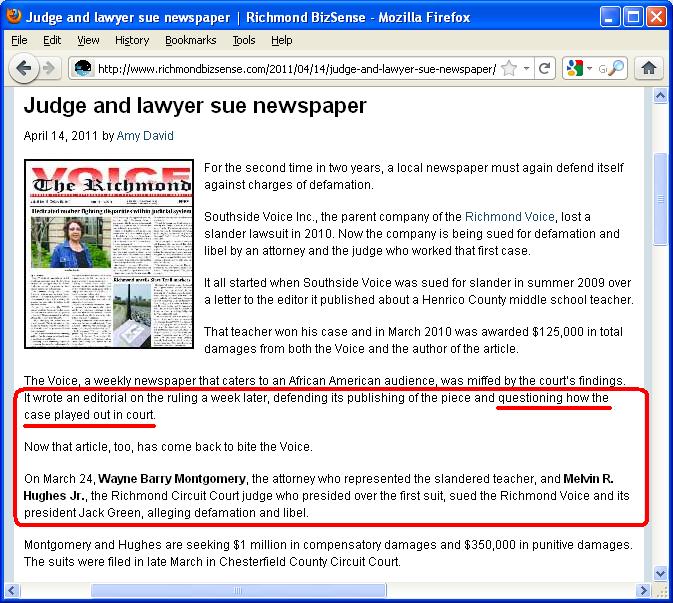
Above: A defamation suit by a member of the judiciary or any other citizen is the most normal thing in the world. Most examples ““ like this case involving the Voice of Richmond, which I selected simply because it was one of the first Google results ““ are related to questioning the appropriateness of courtroom procedures.
Other defamation suits, like Mignini’s claims against the West Seattle Herald’s reporter Steve Shay’s article (“mentally unstable”) or Joe Cottonwood (“intellectually dishonest bully”) are not against incursions limited to question the procedures in a legal case , but against open and baseless personal attacks, as seen from the point of view of the victim.
Is the CPJ concerned about the defamation suit against the Voice of Richmond? Has it published a letter to political leaders and pasted it prominently on its site, claiming that the judge in Richmond should just sit back and take criticism of his courtroom procedures?
If the Voice of Richmond newspaper, instead of being critical of courtroom procedures in a potentially defamatory manner, had associated the judge’s good name with the expression “mentally unstable”, or if the paper had called him an “intellectually dishonest bully”, only then would the CPJ have jumped in to defend the Voice of Richmond’s right to do such name calling?
The conclusions to this test, I must say, are pretty obvious.
My point is that while most people will agree with CPJ that public officials should put up with criticism of their work, we all agree that personal smears (or what the alleged defamation victim and the public could see as a personal smear) certainly should give way to the right to defend one’s honour.
This should be the case not only in the thousands of cases documented in Google that the CPJ doesn’t seem to get worried about (which is good news), but also in the case of Mr. Mignini, whom someone in or very close to the CPJ seems to be especially nervous about (which is disturbing news).
Test 4b, Step 1:
With just the results of Test 4a, I could already proceed to update the Balance Sheet for Testing CPJ’s Anti-Mignini Accusations as regards the example of Mignini suing certain persons or news outlets for personal attacks against his honour.
However, let’s take a fast look at each of those persons or news outlets to see if there are any factors which could change in one direction or another our conclusion that it’s perfectly normal for a person in the judiciary to sue for defamation, in particular when the alleged defamation does not concern his professional activity but his personal characteristics.
Without further ado, let’s carry out another search.
Google: site:oggi.it “oggi.it” amanda knox OR edda OR chris OR mellas (enter)
Each reporter, newspaper and magazine out there has their own view on the personalities in the Meredith Kercher murder case. There are a couple of outlets, like OGGI magazine which for some unknown reason have taken a particular liking to the Knox Mellas family, resulting in the members of this family and their travails getting special coverage, as the Google results show (use the Google translator if need be).
[Above: The Knox-Mellas clan find one corner of ongoing support and sympathetic coverage in Italy in OGGI magazine.]
The fact that this magazine takes a particular view to Amanda Knox’s family is a question of how they want to focus their coverage of this case. Quite another thing are their insinuations about certain elements of the prosecution’s case.
For example, in recent weeks there seems to be an all out attack on the hearing capacity and the mental faculties of Signora Nara Capezzali, a neighbour who on the night of Meredith Kercher’s murder heard the running of multiple persons near the cottage, just after a piercing scream (the danger of this testimony for pro-Knox forces is that it points to more than one person being involved in the crime, including Amanda Knox).
Just for interest’s sake, to see how Amanda Knox friendly voices have latched onto this issue, do another fast Google search: “amanda knox” “nara capezzali” deaf OR crazy OR psychiatric (enter)
OGGI and reporter Giangavino Sulas participated in the attack on Signora Capezzali, and by extension on prosecutor Mignini’s case:
“The witnesses “¦ suffer from sufficiently serious problems of deafness, of physical and also mental health, to be hospitalized in a psychiatric ward (as in the case of Nara Capezzali).” (Source: Giangavino Sulas , OGGI Magazine, April 2011)
This test and the ones that follow are not meant to prove anything in particular as regards Mr. Mignini’s right to defend his honour (which we saw clearly in Test 4a).
However, these additional tests do put some perspective on those who decry Mignini as threatening (or whom CPJ has dug up as “victims” of Mignini ““ I’m not aware that either OGGI, Steve Shay or Joe Cottonwood were searching for the CPJ to ask it to put together its Letter to 21 World Leaders, not even a junior reporter from the diminutive West Seattle Herald could have been able to dream that up).
In addition, if what CPJ is concerned about is “that the press—domestic and international—is free to report and comment on the case without fear of reprisal”, (Source: CPJ followup explanatory note 28-04-2011 ) it is more than evident by consulting recent reporting by OGGI and in particular by Giangavino Sulas, that that magazine and reporter are not holding back in examining and opining on all elements of the prosecution and conviction of the murderers (pending appeal) of Meredith Kercher.
Test 4c, Step 1:
Let’s go to a popular pro-victim discussion board concerning the murder of Meredith Kercher, such as TJMK or the Perugiamurderfile.org. Do a search for Steve Shay, and you will see references to examples on other sites which demonstrate how this reporter swims like a fish amongst pro-Knox social networking friends.
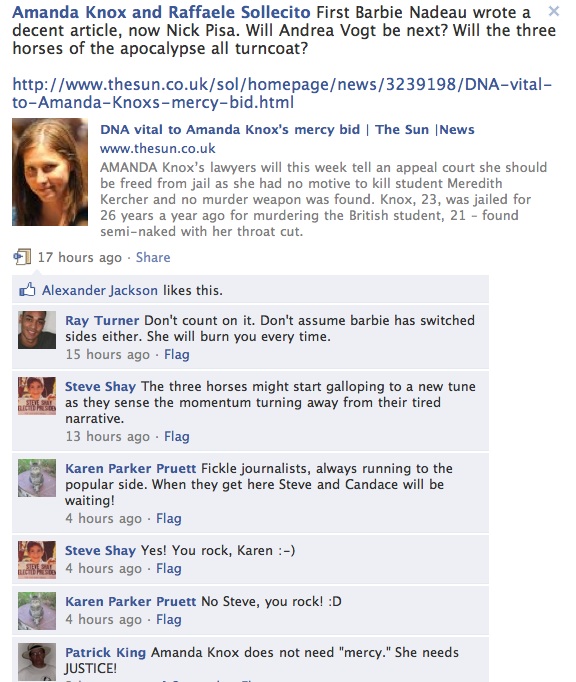
Above: When West Seattle Herald reporter Steve Shay infiltrates Internet social groups to gather information for his next story, he sure does a good job of appearing to be like-minded with his fellow posters, in this case, the Friends of Amanda lobby Facebook group.
(Source: Facebook, image on Perugiamurderfile.org)
Steve Shay’s own social networking postings and his ongoing reporting in the West Seattle Herald demonstrate that Mignini’s potential lawsuit has not made him or his newspaper wither (my personal opinion is that he takes it as a sort of medal that he wears proudly on pro-Knox discussion boards and at FOA money making events).
The CPJ itself states explicitly that “in an email interview with CPJ, West Seattle Herald Editor Ken Robinson said “¦ that the paper does not fear repercussions from Mignini “¦. he and his newspaper were not perturbed by the prosecutor’s actions”.
So why all the fuss in the CPJ Letter to the World about reporters and newspapers holding back in having a go at the Meredith Kercher murder case?
The CPJ itself shows that some reporters like Steve Shay can have their cake and eat it too.
Test 4d, Step 1:
I feel a little sorry for Joe Cottonwood, as he appears to have haplessly stepped into an international scene of attacks against Mr. Mignini. However, if the Italian law says that you can’t call someone an “intellectually dishonest bully”, then you should be careful.
Let’s do a fast test on Mr. Cottonwood.
Type Google: joe cottonwood (enter)
From the Google search results, you can take a look at Cottonwood’s own site, or see a summary of his activity in the Wikipedia page on him: “Joe Cottonwood is an American author of fiction and poetry for adults and children. He was born in 1947 and lives in La Honda, California.” (Source: Wikipedia )
Cottonwood not only doesn’t report on the Meredith Kercher murder case, he isn’t even a reporter, nor even calls himself a blogger or a freelancer or journalist.
You can hardly say that Mignini’s legal action to defend his personal honour will affect Cottonwood’s coverage of the case, which is what CPJ’s Letter to 21 World Leaders is all about as CPJ stated in its clarification commentary on its Open Letter..
The fact that Cottonwood is included in an international missive of a journalists’ sectorial association when that isn’t even his profession makes me think that CPJ (or whoever really prepared the Letter to the World) was scraping the barrel for examples.
Approximate time required to obtain material to be analysed: less than 1 second for Google searches, a few minutes to enter and search discussion forums.
Tests 4a, 4b, 4c, 4d Step 2: Conclusions
If American judges can sue for defamation in situations which are less personally insulting than what Mr. Mignini has had to put up with, and this defamation in America doesn’t provoke CPJ’s intervention, then Mr. Mignini’s personal legal actions can’t be worth a Letter to 21 World Leaders.
In addition, simple observation of your examples of three defamation suits shows that it is not true that Mignini’s legal actions to defend his personal honour have affected news reporters’ coverage of the Amanda Knox case.
It is strange and worrying that the Committee to Protect Journalists for some reason wants to deny Mr. Mignini his constitutional right as an Italian and European citizen to not be the subject of abusive attacks.
Let’s do one final exercise: search Google for Mignini and various hate terms like “mentally unstable” and you could conclude that reporters and anonymous bloggers have made Giuliano Mignini into the second most hated man on the planet after Bin Laden - who now, of course, is dead.
Hate remarks against Mignini are now up in the hundreds of thousands, possibly millions. The BBC looked into just some of the shrill claims made by reporters whom Joel Simon wants to keep supporting in their anti-Mignini drive and actually found nothing there.
We’re moving along, and as usual, the best is yet to come. Let’s update the Balance Sheet for Testing CPJ’s Anti-Mignini Accusations with our latest findings. I fear that the CPJ is not doing well:
[below::The results of the fourth set of credibility tests of the anti-Mignini accusations gives us the feeling that the CPJ has no basis whatsoever for the accusations, nor does it have justification for sending a Letter to 21 World Leaders.]
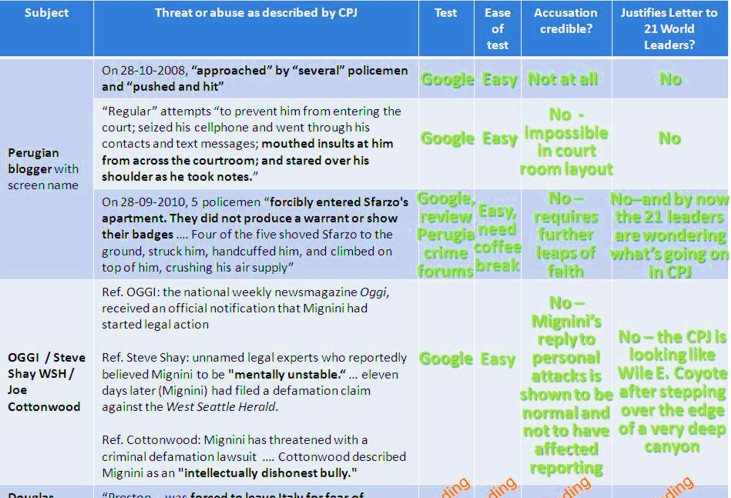
How America’s Premier Justice College Misrepresents Italian Justice - To Global Audience
Posted by brmull
Conflicts between Kassin’s academic and court personas
Saul Kassin is a psychologist with the John Jay College of Criminal Justice in New York. He tries to advance the notion academically and in court that many confessions are coerced by the police and thus false.
In writing about American cases of confessions, Kassin would normally be very sure to interview all the parties to the confession. Police would not simply be sidelined, and the confessor’s tale would not be the only narrative he pays attention to. His academic pieces would normally be peer-reviewed and any claims which were questionable would be examined by the academic peers or the readership. False claims by Kassin could result in criminal complaints and civil lawsuits.
It is quite clear from online postings that Saul Kassin was taken on as a hired gun for the Knox defense in the Knox/Sollecito trial in Perugia. He was being paid NOT to simply be academic and objective, he was being paid to give the police witnesses and prosecution as hard a time as possible.
Although he seems to have flown to Perugia at one point he definitely did not encounter let alone interview even one police officer, even one prosecutor or even one judge. He made no visit to the questura where the Knox questioning took place. He doesnt speak or read Italian so he would not be able to get to grip with original evidence.
He does not reveal if and when he interviewed Amanda Knox herself. She makes no mention of any meeting with Kassin in her book. Kassin was definitely not in court in mid-2009 when Amanda Knox was cross-examined for two days on the witness stand about her false allegations against Patrick Lumumba. Her stint on the stand was regarded as a disaster for her by most of those present.
Conflicts consequentially plaguing Kassin’s academic judgments
During the Hellmann appeal in 2011 [subsequently annulled by the Supreme Court in 2013] Kassin started to use his academic standing and ostensible objectivity to propagate to American and later global audiences his hired-gun take for the defense. He had still not interviewed anyone in the Perugia police or prosecution.
He never made clear that his description of Knox’s interrogation was already UNIVERSALLY discredited in Italy - and that even Knox had admitted that the police treated her fairly. He never explained what peer review process his many pieces went through. Not one police officer or prosecutor in Perugia was contacted by any peer reviewer seeking confirmations. This suggests either that there was no peer review or it was unethically cooked in some way.
Our own peer reviews of Kassins proliferating claims
One month ago my fellow poster the Machine took apart ten claims which Saul Kassin made last year in a Seattle radio interview. As the Machine showed, every one of those claims fall apart once one refers to official documents and the more objective case books and websites.
Another post one month ago by my fellow poster Fuji showed that Amanda Knox is NOT likely to issue false confessions in the heat of an interrogation moment.
That is Kassin’s key claim here, and in effect Fuji used Kassin’s own “science” against him.
Then we were warned by a John Jay colleague critical of Kassin that he had repeated these same spurious claims live on television - and that Kassin had made even more wrong claims in a keynote speech to a conference of the elite John Jay College in June in New York, in front of an influential international audience.
And he did so again in a paper, possibly peer-reviewed, which the respected journal American Psychologist has placed online. This post provides the truth on the Knox-related claims at the front and back ends of that American Psychologist paper.
Saul Kassin still appears to want to argue that Amanda Knox was convicted ONLY based on a false confession (as the Machine and numerous posts on TJMK show, she wasn’t - and in fact, Knox didn’t even confess) and he now makes almost 50 erroneous assertions about the case.
You can see highlighted in the first box-quote below those misleading and erroneous passages of PR shill Kassin which I correct in the second box-quote below.
(1) SAUL KASSIN’S ORIGINAL VERSION WITH WRONG STATEMENTS HIGHLIGHTED
As illustrated by the story of Amanda Knox and many others wrongfully convicted, false confessions often trump factual innocence. Focusing on consequences, recent research suggests that confessions are powerfully persuasive as a matter of logic and common sense; that many false confessions contain richly detailed narratives and accurate crime facts that appear to betray guilty knowledge; and that confessions in general can corrupt other evidence from lay witnesses and forensic experts””producing an illusion of false support. This latter phenomenon, termed “corroboration inflation,” suggests that pretrial corroboration requirements as well as the concept of “harmless error” on appeal are based on an erroneous presumption of independence among items of evidence. In addition to previously suggested reforms to police practices that are designed to curb the risk of false confessions, measures should be taken as well to minimize the rippling consequences of those confessions….Meredith Kercher was found raped and murdered in Perugia, Italy. Almost immediately, police suspected 20-year-old Amanda Knox, an American student and one of Kercher’s roommates””the only one who stayed in Perugia after the murder. Knox had no history of crime or violence and no motive. But something about her demeanor””such as an apparent lack of affect, an outburst of sobbing, or her girlish and immature behavior”” led police to believe she was involved and lying when she claimed she was with Raffaele Sollecito, her new Italian boyfriend, that night.
Armed with a prejudgment of Knox’s guilt, several police officials interrogated the girl on and off for four days. Her final interrogation started on November 5 at 10 p.m. and lasted until November 6 at 6 a.m., during which time she was alone, without an attorney, tag-teamed by a dozen police, and did not break for food or sleep. In many ways, Knox was a vulnerable suspect””young, far from home, without family, and forced to speak in a language in which she was not fluent. Knox says she was repeatedly threatened and called a liar. She was told, falsely, that Sollecito, her boyfriend, disavowed her alibi and that physical evidence placed her at the scene. She was encouraged to shut her eyes and imagine how the gruesome crime had occurred, a trauma, she was told, that she had obviously repressed. Eventually she broke down crying, screaming, and hitting herself in the head. Despite a law that mandates the recording of interrogations, police and prosecutors maintain that these sessions were not recorded.
Two “confessions” were produced in this last session, detailing what Knox called a dreamlike “vision.” Both were typed by police””one at 1:45 a.m., the second at 5:45 a.m. She retracted the statements in a handwritten letter as soon as she was left alone (“In regards to this “˜confession’ that I made last night, I want to make it clear that I’m very doubtful of the verity of my statements because they were made under the pressures of stress, shock, and extreme exhaustion.”). Notably, nothing in the confessions indicated that she had guilty knowledge. In fact, the statements attributed to Knox were factually incorrect on significant core details (e.g., she named as an accomplice a man whom police had suspected but who later proved to have an ironclad alibi; she failed to name another man, unknown to police at the time, whose DNA was later identified on the victim). Nevertheless, Knox, Sollecito, and the innocent man she implicated were all immediately arrested. In a media-filled room, the chief of police announced: Caso chiuso (case closed).
Police had failed to provide Knox with an attorney or record the interrogations, so the confessions attributed to her were ruled inadmissible in court. Still, the damage was done. The confession set into motion a hypothesis-confirming investigation, prosecution, and conviction. The man whose DNA was found on the victim, after specifically stating that Knox was not present, changed his story and implicated her while being prosecuted. Police forensic experts concluded that Knox’s DNA on the handle of a knife found in her boyfriend’s apartment also contained Kercher’s blood on the blade and that the boyfriend’s DNA was on the victim’s bra clasp. Several eyewitnesses came forward. An elderly woman said she was awakened by a scream followed by the sound of two people running; a homeless drug addict said he saw Knox and Sollecito in the vicinity that night; a convicted drug dealer said he saw all three suspects together; a grocery store owner said he saw Knox the next morning looking for cleaning products; one witness said he saw Knox wielding a knife.
On December 5, 2009, an eight-person jury convicted Amanda Knox and Raffaele Sollecito of murder. The two were sentenced to 26 and 25 years in prison, respectively. Finally, on October 3, 2011, after having been granted a new trial, they were acquitted. [Actually they still stand accused - and facing a tough fact-based prosecution appeal] Ten weeks later, the Italian appeals court released a strongly worded 143-page opinion in which it criticized the prosecution and concluded that there was no credible evidence, motive, or plausible theory of guilt. For the four years of their imprisonment, this story drew international attention (for comprehensive overviews of the case, see Dempsey, 2010, and Burleigh, 2011).1
It is now clear that the proverbial mountain of discredited evidence used to convict Amanda Knox and Raffaele Sollecito was nothing but a house of cards built upon a false confession. The question posed by this case, and so many others like it, is this: Why do confessions so often trump innocence? ...
Third, it is important to realize that not all evidence is equally malleable or subject to corroboration inflation. Paralleling classic research indicating that expectations can color judgments of people, objects, and other stimuli that are ambiguous as opposed to those that compel a particular perception, forensic research indicates that ambiguity is a moderating condition. Asked to report on an event or make an identification decision on the basis of a memory trace that cannot be recovered, eyewitnesses are particularly malleable when confronted with evidence of a confession (Hasel & Kassin, 2009). This phenomenon was illustrated in the case against Amanda Knox. When police first interviewed Knox’s British roommates, not one reported that there was bad blood between Knox and the victim. After Knox’s highly publicized confession, however, the girls brought forth new “memories,” telling police that Kercher was uncomfortable with Knox and the boys she would bring home (Burleigh, 2011). ...
In recent years, psychologists have been critical of the problems with accuracy, error, subjectivity, and bias in various types of criminal evidence””prominently including eyewitness identification procedures, police interrogation practices, and the so-called forensic identification sciences, all leading Saks and Koehler (2005) to predict a “coming paradigm shift.” With regard to confessions, it now appears that this shift should encompass not only reforms that serve to minimize the risk of false confessions but measures designed to minimize the rippling consequences of those confessions””as in the case of Amanda Knox and others who are wrongfully convicted.
(2) MY REPLACEMENT VERSION WITH CORRECT FACTS AND CONTEXT NOW INCLUDED
On November 2, 2007, British exchange student Meredith Kercher was found sexually attacked and murdered in Perugia, Italy. The next day, 20-year-old Amanda Knox, an American student and one of Kercher’s roommates, became a person of interest, along with Meredith’s downstairs neighbors and several of her other acquaintances. Interviewing close contacts is a cornerstone of police work. Two of Meredith’s close English friends, who were so scared they couldn’t sleep alone, left Perugia in the immediate aftermath of the murder. Everyone else stayed on.Months before arriving in Perugia, Knox received a citation for a noise violation when a going-away party she’d thrown for herself in Seattle got out of hand. One of the officers described it as a “scene from Baghdad.” Within about three weeks of moving into the cottage in Perugia, Knox was ejected from a nightclub for pouring her glass on the head of a disc jockey.
It’s often said that Knox had no motive to kill Meredith, but it was Knox’s claim of drug use which indicated a possible motive: a drug-fuelled assault. There are various others, though a motive is not actually required for conviction. In crime scene videos from the day Meredith’s body was discovered, Knox can be seen outside the cottage glancing furtively around. Still, it was not this and other odd behavior, but rather the many conflicting witness statements by Knox and her new Italian boyfriend, Raffaele Sollecito, that led police to believe Knox was involved and lying when she claimed she was with Sollecito at his home continuously on the night of November 1.
Police interviewed dozens of witnesses in the days after the murder, some more than once. All witness statements were written down and signed for, not recorded. The police interviewed Sollecito for the third time beginning at 10:40pm on November 5. Knox later testified that she voluntarily accompanied her boyfriend to the station, because she didn’t want to be alone. The police did not summon her. To the interviewers’ surprise, Sollecito repudiated his earlier alibi when shown phone records, and now said Knox had left his apartment for much of the evening. Some time after 11:00pm the police asked if they might interview Knox. An interpreter was called and by 1:45am Knox had given a signed statement that she had witnessed the sounds of her employer, bar owner Patrick Lumumba, murdering Meredith at the cottage.
In that statement she acknowledged that she had been given an interpreter, and that she herself was now officially a suspect. Knox later testified that she was treated well. She was offered snacks and drinks during the interview and afterward. Made aware that she could not be interrogated without a lawyer, but still anxious to put out as much information as possible, she then requested a chance to make a spontaneous statement without any questioning. Dr Mignini, the magistrate on duty, was called from his home, and she gave a statement in front of him very similar to her witness statement from hours earlier. He asked no questions.
Knox and the police gave different accounts of how the 11:00 to 1:45 am interview was conducted. Police said Knox was told Sollecito now no longer confirmed her alibi and he had called her a liar. She now had no alibi. Sympathetic to her because Knox was freaking out, the interpreter urged her to try to remember at least something. Shown a text she had sent to Lumumba at 8:35pm saying “See you later. Have a good evening!” she was asked to explain this. The police describe how Knox started to cry and burst out, “It’s him! It’s him!”
Both Knox’s witness statement at 1:45 a.m and her voluntary suspect statement at 5:45am were written out in Italian and translated back to her before she signed. After Knox was formally taken into custody at midday on November 6, she asked for paper and wrote a slight modification of her earlier statements, adding: “In regards to this “˜confession’ that I made last night, I want to make it clear that I’m very doubtful of the verity of my statements because they were made under the pressures of stress, shock, and extreme exhaustion.”
Lumumba was arrested along with Knox and Sollecito. Knox and her mother held out on his non-involvement for weeks, but he was eventually determined to have a solid alibi. Another man, Rudy Guede, was identified through a hand print in Meredith’s bedroom. Knox appeared to have substituted Lumumba for Guede in her statements, and several details of the crime in her so-called confession were later corroborated by witnesses.
Because police had not needed to provide Knox with an attorney at the impromptu witness interview after 11:00, the Supreme Court ruled that statement inadmissible in the murder case against her. However both statements were ruled admissible in court for the purpose of establishing the crime of defamation against Patrick Lumumba. Knox’s November 6 letter was also ruled admissible.
Guede, the man whose DNA was found on the victim, told a friend while he was still on the run that he had found Meredith stabbed and that Knox had nothing to do with the murder. However, in the same conversation, which was recorded by police, he speculated that Knox and Sollecito might have been at the cottage. In a letter dated March 7, 2010, while his sentence was awaiting final confirmation by the Supreme Court, Guede wrote that Knox and Sollecito murdered Meredith. He reiterated this claim as a witness during Knox and Sollecito’s appeal.
Forensic police from Rome concluded that a kitchen knife found in Sollecito’s apartment had Knox’s DNA on the handle and Meredith’s DNA on the blade. Sollecito’s DNA was on the victim’s bra clasp in Meredith’s locked bedroom.
Several eyewitnesses came forward. Three neighbors testified that they heard a disturbance around 11:30pm in the vicinity of the cottage. A homeless man who at appeal admitted heroin use was reading a newsmagazine at the basketball court near the cottage. He testified that he saw Knox and Sollecito four or five times that night. An Albanian, a possible drug dealer. who the Massei court deemed unreliable after the Micheli court accepted him, said he had seen all three suspects together, and that Knox had accosted him with a knife. A grocery store owner testified he saw Knox at his shop early on the morning after the murder.
The conflicting alibis of the two were never resolved during trial. On December 4, 2009, an eight-person panel consisting of two professional judges and six lay judges found Amanda Knox and Raffaele Sollecito guilty of murder aggravated by sexual assault, simulation of a burglary, unlawful carrying of a knife and, in Knox’s case, criminal defamation of Patrick Lumumba. The two were sentenced to 26 and 25 years in prison, respectively….
Knox’s mother later described her daughter as “oblivious to the dark side of the world.” Knox herself wrote that, on the night of the murder, she and Sollecito were talking about his mother’s suicide. She told him her philosophy was “life is full of choices and that these choices are not necessarily between good and evil, but between what’s better and what’s worse.”...
Results of our own peer-group analysis
Kassin asserted that the witnesses in this case imagined “new memories” unfavorable to Knox because of her highly-publicized confession. He referenced an experiment in which an unknown actor walked into a classroom and stole a laptop. The students were asked to try to identify the thief from a line-up. Two days later, the students were told which person in the line-up had confessed. Many changed their minds when told of the confession, although in truth the thief was never in the line-up at all.
Obviously this contrived scenario has nothing at all to do with Amanda Knox or people who had met her.
In his book, Meredith, the victim’s father John Kercher recalls his daughter complaining about Knox’s poor hygiene and how she brought home strange men several weeks before the murder. Numerous witnesses recounted specific anecdotes of Knox’s sharp-elbowed and offputting behavior. Her circle of friends quickly diminished only to Sollecito.
Really, could all these be “new memories”?
Psychologists studying eyewitness testimony, interrogation techniques and false confessions need to be circumspect. Even DNA testing, considered the best of the forensic sciences, requires a thorough understanding of circumstances in order to be interpreted correctly.
Kassin’s continued stonewalling and legal risks
I really wonder who agreed to publish him. I work in a science-based field. When I first learned Kassin had been recruited by Curt Knox’s hatchet men as a PR shill, had been put directly in touch with Knox herself, and had been provided with pre-selected reading materials, I wrote to ask him why he hadn’t disclosed all this to his readers.
Still no reply.
It’s true that numerous talking heads have exaggerated their qualifications and concealed their conflicts of interest and financial stakes when speaking in support of the defense. Judge Mike Heavey abused his oath of office to try to sway the process.
What’s different about Kassin is that, using his John Jay College aura, he has corrupted the scientific record with misinformation.
And he has done this, at least in part, with the goal of misleading an Italian court. These dirty tricks are especially dangerous because most people, including judges, expect that what’s stated as fact in prominent academic journals is objective and true.
Kassin looks to us nothing like an academic here. He looks instead like a defense hired gun who (only in English and only in America) has repeatedly falsely accused police officers of serious felonies in how they questioned Knox as a witness.
If even a single complaint is lodged in Italy and Kassin cannot prove his 50 or so seemingly-spurious and very damaging claims, he could find himself facing years in an Italian prison for attempted obstruction of justice.
Kassin’s peers need to press him for the truth once and for all, and to stop him using his academic mantle illegally and academically unethically as a cloak for a sleazy defense campaign.
[Everything in this post applies equally to the ludicrously inaccurate claims of ex FBI “mindhunter” John Douglas in his books and lobbying at the State Department.]

